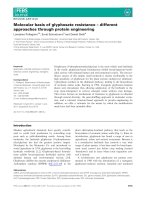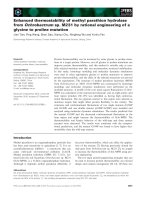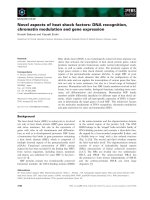Báo cáo khoa học: "Practical aspects of federalizing disaster response." pot
Bạn đang xem bản rút gọn của tài liệu. Xem và tải ngay bản đầy đủ của tài liệu tại đây (38.44 KB, 3 trang )
Page 1 of 3
(page number not for citation purposes)
FEMA = Federal Emergency Management Agency; DOD = Department of Defense.
Available online />On 25 September 2005, the US President, responding to
growing criticism of the response to Hurricane Katrina, said
‘… is there a natural disaster – of a certain size – that would
then enable the Defense Department to become the lead
agency in coordinating and leading the response effort?
That’s going to be a very important consideration for
Congress to think about.’ [1]. Five days later his brother
wrote, ‘As the Governor of a state that has been hit by seven
hurricanes and two tropical storms in the past thirteen
months, I can say with certainty that federalizing emergency
response to catastrophic events would be a disaster as bad
as Hurricane Katrina … Before Congress considers a larger,
direct federal role, it needs to hold communities and states
accountable for properly preparing for the inevitable storms
to come.’ [2].
There is no doubt that Hurricane Katrina overwhelmed the
local and state governments of Louisiana and, to a lesser
degree, the Federal Emergency Management Agency
(FEMA). However, as Governor Bush has pointed out, the
current system has served us well in the past. Is Louisiana an
aberration or must we federalize our response to disaster? It
is essential to understand that, under existing law, the federal
role is to ‘… supplement state and local resources in major
disasters or emergencies.’ [3]. The most significant errors
during Katrina were the failure of the city to evacuate the
100,000 residents without cars and the inability of local,
state, and FEMA personnel to work together. As we move
into an examination of federalizing disaster response, for the
sake of brevity we shall focus on these two issues, namely
evacuation, and command and control of the response effort.
A federal/state exercise called Hurricane Pam, conducted in
July 2004, was a simulation of a category 3 storm hitting New
Orleans. It clearly forecast exactly what happened in Katrina
and demonstrated that the evacuation of New Orleans would
take at least 72 hours [4]. Mayor Nagin declared a mandatory
evacuation less than 24 hours before Katrina’s landfall [5].
Additionally, no direction was given to potential evacuees
regarding destination [6]. The lateness of the evacuation
decree invalidated the state’s disaster plan, which calls for
buses to take the 100,000 residents without cars out of the
city once the Governor declares a state of emergency.
Governor Blanco made this declaration 66 hours before
Katrina’s landfall [4]. Mayor Nagin’s failure was partially
execution but primarily preparation. Terry Ebbert, the Director
of Emergency Management for the city, said ‘We always
knew we did not have the means to evacuate the city.’ [4]. I
know Terry Ebbert personally; if he says the plan for
evacuation is unworkable, then that is proof enough for me.
The evacuation failed because New Orleans was not
‘properly prepared’ for an inevitable event.
Would having the Department of Defense (DOD), as the
President suggested, as the lead federal response agency
have ensured a successful evacuation? Certainly not; there
was not yet a disaster to respond to. The news media made
much of the unused city and school buses [6], but who was
supposed to drive those buses? Is it realistic to expect transit
and school bus drivers to remain in the city until mandatory
evacuation is ordered, or will they have moved with their
families out of the city during the voluntary evacuation phase?
Many expressed surprise that significant numbers of public
employees (including Transportation Security Agency
personnel from New Orleans airport) evacuated with the
‘civilians’. In fact, they are civilians; the only people that can
be ordered to remain in the face of imminent danger are
military personnel. Have we come full circle, back to the
President’s proposal? No; the President proposed a federal
solution, using DOD (active duty) military personnel. Jeb
Bush is correct – federalizing is not the solution. However,
each state has its own military, namely the National Guard.
There are four primary reasons for using the National Guard
rather than active duty forces for domestic support:
responsiveness, unity of command, readiness, and posse
comitatus. A governor does not have to request his state’s
National Guard to participate; he owns it. If the President
Commentary
Practical aspects of federalizing disaster response
James L Clark
Col (ret), Highlands, North Carolina, USA
Corresponding author: James L Clark,
Published: 14 December 2005 Critical Care 2006, 10:107 (doi:10.1186/cc3939)
This article is online at />© 2005 BioMed Central Ltd
Page 2 of 3
(page number not for citation purposes)
Critical Care Vol 10 No 1 Clark
sends active duty forces, he retains command thereof; it is
not possible to subordinate active duty forces to a state
government. The National Guard already has a domestic
support mission; they are ready, trained and equipped. The
active force is not ready for this mission, assuming this
mission would damage their readiness in current mission
areas. The Posse Comitatus Act is a law dating back to 1878
that forbids use of federal troops in law enforcement [7]. It
does not apply to the Coast Guard unless it is assigned to
the DOD during war or to the National Guard, unless
federalized. The impact of this law on federal troops used in
domestic support is incapacitating. To give two examples at
either end of the spectrum, federal troops cannot direct
traffic, and neither can they defend a policeman who is
outnumbered, outgunned, and under attack; federal troops
can only defend themselves when they are under direct life-
threatening attack. This is not a legal scholar’s classroom
interpretation of the law. These were part of the formal DOD
rules of engagement I worked under as the Commanding
Officer of 23rd Marines while conducting counter-narcotics
operations on the Mexican border.
Turning to the issue of local, state, and FEMA personnel not
functioning as a team, the controversial statement by Michael
Brown – former FEMA Director – that Louisiana was
dysfunctional well before Katrina’s landfall [8] appears to be
well supported by the facts. ‘The state and local government
[in New Orleans] command and control there were nothing
short of pathetic … leaders refused to communicate with
each other and the Federal government elements … essential
personnel were AWOL … decision making was non-existent.’
[9]. Frustrated with state incompetence, the President sought
to federalize the relief effort on 2 September; Governor
Blanco refused. ‘We’re still fighting over authority’, Mayor
Nagin said the following day [10]. Martha A Madden, former
Secretary of the Louisiana Department of Environmental
Quality, said she believes that a critical systemic breakdown
occurred at the moment the levee broke. She said
contingency plans have been in place for decades but were
either ignored or improperly executed [11]. Would replacing
FEMA, as lead federal agency, with the DOD have prevented
meltdown of state government? Only if DOD supplanted,
rather than supplemented, state government. When the
President proposed federalizing the National Guard and the
recovery, it was an attempt essentially to supplant state
government. When the Governor refused, martial law was
discussed both in the media and within the Whitehouse.
Most legal scholars define martial law as the suspension of
habeas corpus (imprisonment without due process or appeal)
and military assumption of police powers. Martial law was
severely limited by the Supreme Court in 1863; it can only be
imposed when civil authority (the courts) cannot operate [12].
The Posse Comitatus Act effectively eliminates federally
imposed martial law except in three circumstances [13]:
insurrection or rebellion, crimes involving nuclear materials,
and emergency situations involving chemical or biological
weapons of mass destruction [13]. I use Northcom’s website
as reference here [13] to demonstrate that their Commander
is fully aware of the limitations on the President’s power in
this area. Forget (federal) martial law in disasters – it’s not
going to happen. However, each state has laws granting the
governor exceptional executive powers. In Louisiana it is
called a state of public health emergency, and when declared
it permits the governor to suspend laws, order evacuations,
and limit sale of items such as liquor and firearms [14]. This
power essentially equates to martial law; however, note that it
is implemented and enforced by the state (another argument
for using the National Guard). Governor Blanco declared this
state of emergency on 26 August 2005, to expire on 25
September 2005.
As for FEMA’s performance, most of the criticism is the result
of one of three factors – misunderstanding of FEMA’s role,
underestimation of the scope of Katrina’s damage, and
ignorance of the incompetent performance of the state
authorities – or a combination of two or all of these factors.
FEMA is not a first responder, has no internal response
assets, and consists of less than 3000 employees spread
nationwide. FEMA coordinates federal response assistance
through the state Emergency Operations Center. If the
Emergency Operations Center is dysfunctional, then FEMA
cannot perform its mission. Katrina’s damage was spread
over 90,000 square miles, with the most severe damage in
Mississippi, not Louisiana. The unified command and control
that FEMA depends on was functional in Florida, Alabama
and Mississippi, but was absent in Louisiana [15]. Has FEMA
suffered a decline after being folded into the Department of
Homeland Security? Absolutely, but this was not the critical
factor in FEMA’s poor performance [16]. Finally, it is
becoming obvious that exaggerations of mayhem by officials
and rumors repeated uncritically in the news media slowed
FEMA’s response in New Orleans [17].
In conclusion, Governor Bush is correct. We must hold local
and state governments accountable for proper preparation
for disasters. The President is partially correct – the military
must play a greater and earlier role in catastrophic-scale
disasters – but it must be the National Guard, not the DOD,
that is involved. An active duty soldier or Marine would make
no better policeman than a policeman would a combat
infantryman. Finally, FEMA should be removed from the
Department of Homeland Security and restored to its
previous status.
Competing interests
The author(s) declare that they have no competing interests.
References
1. VandeHei J, White J: Bush urges shift in relief responsibilities.
Washington Post 2005, 26 September:A12
2. Bush J: Think locally on relief [OpEd]. Washington Post 2005,
30 September:A19.
Page 3 of 3
(page number not for citation purposes)
3. Congressional Research Service Memorandum: Hurricane
Katrina – Stafford Act Authorities. 12 September 2005. Internal
congressional memo to representative John Conyers.
( />4. Glasser SB, Grunwald M: The steady buildup to a city’s chaos.
Washington Post 2005, 11 September:A01.
5. Yourish K, Stanton L, Tate J: Hurricane Katrina: what went
wrong? Washington Post 2005, 11 September:2.
6. Pierre RE: New Orleans mayor faces tough questions. Wash-
ington Post 2005, 10 September:A14.
7. US code 18 section 1385 ( />ts_search.pl?title=18&sec=1385)
8. Hsu SS: Brown defends FEMA’s efforts. Washington Post
2005, 28 September:A01.
9. Anonymous: FEMA under scrutiny in hearings. Washington
Post [ />2005/09/27/DI2005092701348_pf.html]
10. VandeHei J: Officials deal with political fallout by pointing
fingers. Washington Post 2005, 9 September:A17
11. White J, Whoriskey P: Planning, response are faulted. Washing-
ton Post 2005, 2 September:A01
12. ex parte Milligan (71 US 2; 1866). [onstitution.
net/consttop_mlaw.html#milligan]
13. Posse Comitatus Act
[ />news.factsheets&factsheet=5#pc)]
14. The US Constitution Online: Constitutional topic: martial law.
[ />15. Testimony of Michael D Brown before Congress. 27 September
2005.
16. Glasser SB, White J: Storm exposed disarray at the top. Wash-
ington Post 2005, 4 September:A01.
17. Pierre RE, Gerhart A: News of pandemonium may have slowed
aid. Washington Post 2005, 10 October 2005:A08.
Available online />









